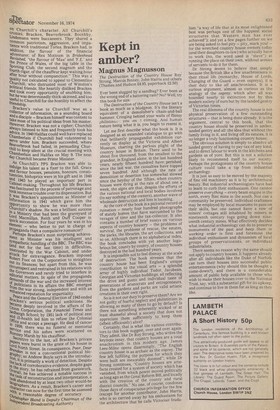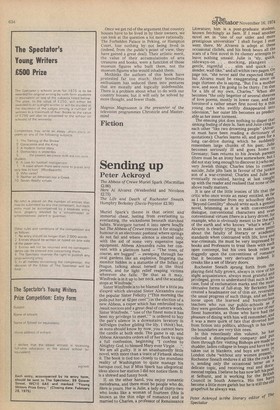Kept in amber?
Magnus Magnusson
The Destruction of the Country House Roy Strong, Marcus Binney, John Harris and others (Thames and Hudson £4.95, paperback £2.50) Ever been slugged by a sandbag? Ever been at the wrong end of a battering ram? No? Well, try this book for size.
The Destruction of the Country House isn't a book so much as a bludgeon. It's the literary equivalent of a demolisher's chain-and-ball hammer. Cringing behind your walls of flimsy ohilistinso. you see t corning. And human nature being what it is, you begin to resent it.
Let me first describe what the book is. It is designed as an extended catalogue to go with that brilliantly propagandist exhibition currently on display at the Victoria and Albert Museum, charting the parlous plight of the country house in Britain. There used to be about five thousand, from the smallest to the grandest, in England alone; in the last hundred years, nearly fifteen hundred have perished; since the last war, the casualties have topped seven hundred. And although the rate of demolition or desertion has somewhat slowed since the heyday of the 'fifties, when country houses were dying at the rate of about one a week, the signs are that, despite the efforts of the various national and local bodies involved (to say nothing of the owners), another wave of wholesale destruction and loss is looming. At the core of the book is a pictorial record of ruination — nearly four hundred photographs of stately homes that have succumbed to the ravages of time and the tax-collector. It also contains a number of brief essays on various aspects of country housery — the problems of survival, the problems of rescue, the estates, the parks, the libraries, the art collections, and so on. Although there is no alphabetical index, the book concludes with yet another lugubrious list, county by county, of country houses destroyed in the last hundred years. It is impossible not to feel dismay at the scale of destruction. The book stresses that the country house has been England's unique contribution to the visual arts — a splendid array of highly individual Tudor, Jacobean, Georgian and Victorian buildings, all reflecting the drive and gusto and individual taste of generations of aristocrats and entrepreneurs. Even the gardens and parks are valid artistic creations in their own right. So is it not our duty to preserve them? Are we not guilty of fearful neglect and philistinism in allowing so many of them to go by default? Is there not something inherently wicked or at least shameful about a society that does not appreciate them sufficiently to keep them (albeit officiously) alive?
Certainly, that is what the various contributors to this book suggest, over and over again. They admit, like Dr Roy Strong, who writes the keynote essay, that country houses are a total anachronism in this modern age. James Lees-Milne opens disarmingly, "The English country house is as archaic as the osprey. The few left fulfilling the purpose for which they were built are inexorably doomed"; while Dr Strong continues, "Country houses are artefacts created for a system of society which has vanished, from which power moved politically as long ago as the Great Reform Bill, and locally with the creation of the county and rural district councils." No one, of course, condones those days of conspicuous privilege for the few (except for another contributor, John Harris, who is so carried away by his enthusiasm for the architecture that he calls Victorian feuda
lism "a way of life that at its most enlightened best was perhaps one of the happiest social structures that Western man has ever achieved"); and yet a few pages further on we are being asked to feel pity — pity, mark you! — for the wretched country house owners today (and their daughters-in-law) who actually have to work (no, the word used is "slave") at running the place on their own, without armies of servants to do it for them.
Dr Strong seems to believe that simply because the British like a few anachronisms in their ritual life (monarchy, House of Lords, Changing of the Guard — even ospreys), it is their duty to like all anachronisms. It is a curious argument, almost as curious as the analogy of the osprey, which after all was hounded nearly to extinction not by this modern society of ours but by the landed gentry of Victorian times.
The real dilemma of the country house is not physical preservation of a few outstanding structures — that is being done already. It is the argument, central to this book, that the country house should be preserved in amber, landed gentry and all: the idea that without the family living in it, and living off its estates, it is no longer a truly functioning country house.
The obvious solution is simply to absolve all landed gentry of having to pay tax of any kind, and to direct labour to work in the kitchens and gardens as of yore. But this is not a solution likely to recommend itself to our society. Perhaps the protagonists of the country house culture could take a tip from industrial archaeology.
It is just as easy to be moved by the majesty of fine old machinery as it is by architectural beauty. But industrial archaeologists have had to learn to curb their enthusiasm. One cannot preserve everything — every beam engine in the north, every flint mine in the south. Nor can a community be preserved. Individual craftsmen may be employed by local museums to pass on their skills, but one cannot have a row of miners' cottages still inhabited by miners in nineteenth century togs going down nineteenth century mines. What effectively decides what industrial archaeology can do to preserve monuments of the past and keep them in working order is first and foremost the individual enthusiasm and dynamism of local groups of preservationists, or individual industrialists.
There seems no reason why the same should not apply to country houses. It happens already after all: individuals like the Duke of Norfolk can turn their houses into successful public entertainments (why should this be thought a come-down?), and there is a considerable amount of public help available to those who wish to make their houses over to the National Trust, say, with a substantial gift for its upkeep, and continue to live in them for as long as they like. • Once we get rid of the argument that country houses have to be lived in by their owners, we can look at the question a lot more rationally. The Forbidden Palace in Peking, or Hampton Court., lose nothing by not being lived in (indeed, from the public's point of view, they have gained a great deal). Their artistic merit, the value of their accumulations of arts treasures and books, were a function of those museum figures who built them, not the museum figures who would inhabit them.
Methinks the authors of this book have protested far too much; their boundless enthusiasm has seduced them into postures that are morally and logically indefensible. There is a problem about what to do with our country houses; but it will only be solved by more thought, and fewer thuds.
Magnus Magnusson is the presenter of the television programmes Chronicle and Mastermind



































 Previous page
Previous page